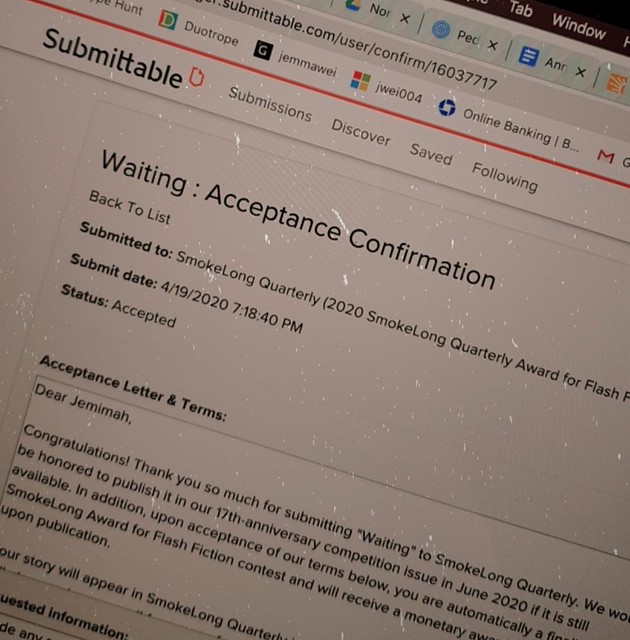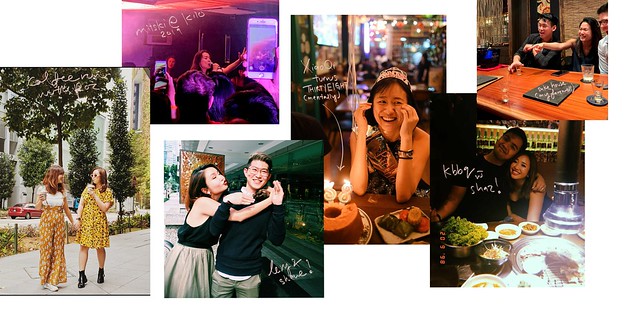
Scribble scrabble.
2060| Ping! Ping! A submarine
One thing I’d forgotten about while in the US was the constant pitting of Shane and my music tastes against each other. Quick question: in the car, who decides the playlist, the driver, or the passenger? Shane and I have completely contrary choices in music, given that I listen mainly to musical soundtracks and he listens to trash, aka, viral tiktok songs. Plus, neither of us like to take turns. Cue: an endless wrestling over the sound controls…
It brings me great shame to say that Shane’s recent obsession, which I couldn’t stand at first, has gotten to me. It’s a song for children and includes a backing track of baby’s laughter, which gives me actual nightmares. Recently, every time he’s pulled up at my void deck, it’s been the same: with his phone already plugged in and the song in mid-blast. Usually I’d wait till he starts driving, then try to sneakily unplug his phone and replace it with mine… but the other day, I was making eggs alone in the middle of the night, and when the oil hit the pan, and sizzled, I found myself murmuring, Ping! Ping! A submarine, Phew! Phew! helicopter, which was when I knew that I was, unequivocally, losing it.
x
Jem
#2059| Full Circle
My girlfriend: do you feel like years of blogging has prepared you for this
Me: one hundred percent absolutely yes
I’m now a columnist for NY-based socially distanced publication, No Contact Magazine. New CNF piece every Monday Eastern Standard Time – it’s been really fun for me to have a space to explore a variety of forms and techniques, especially in a space separate from my regular writing (fiction, long-form). The first piece was structured as a bingo card, and the second was in second-person, which is a criminally underutilized form. Though I must say that I did read an excellent second-person piece recently, the 2008 Natalie Diaz short story, How To Love a Woman With No Legs, in Volume 38 of The Iowa Review, which left me gasping for breath.
Read Curbside: Between Two States.
Read Curbside: Limited Permissions.
Read the far superior Natalie Diaz’s How To Love a Woman With No Legs.
x
Jem
#2058 | Recent Google Searches
1. “hard to focus??”
2. “are migraines normal for your mid-twenties”
3. “coronavirus nyc”
4. “durian flowering season”; “types”
5. “this is not a pipe”; “treachery of images”
6. “how to make espresso at home”
7. “what do bed bugs eat”
8. “mask breakout”; “mask-cne”
9. “first amendment rights”
10. “gunny sack”; “cleaver”; “duri”
11. “bad behavior during coronavirus”
12. “platypus milk”
13. “contact tracing scout”; “reddit” “corona”
14. “is jajabings useless”
15. “is scrivener worth it”
16. “why is Gmail so slow”; “is Gmail slow”
17. “how to speed up computer”
18. “time dilation”
19. “how to eat spicy food”; “improve spice tolerance”
20. “where is my bin google docs”
#2057 | Creepy McCreepz
SmokeLong was putting together a playlist for the issue, and asked me to pick a song to represent “Waiting”! IT WAS THE MOST FUN I HAD ALL WEEK.
Shortlisted songs:
It ended up being between Paloma Faith’s Only Love can Hurt like This, Blondie’s One Way or Another, or Heart of Glass, another Blondie song. I wanted something a bit upbeat and crazy, but with undertones of hurt. Blondie’s One Way or Another is super fun, iconic, and worked the stalker aspect, but Paloma’s paired with the story would play into the nuances of love between friends that can often hold as much, if not more emotional power than that of the romantic narratives we are raised on. I’m interested in female friendships, the richness, complexities and devastation that they can hold, and lyrically, Heart of Glass was the perfect fit: Once I had a love and it was divine / Soon found out I was losing my mind / It seemed like the real thing but I was so blind / Mucho mistrust, love’s gone behind. Hiding hurt behind upbeat punk pop; harboring feelings of betrayal and hurt behind action and obsessiveness. Mmmm. Yum.
I couldnt stop laughing, imagining the editors’ faces if I sent the Paloma song in. In the end I chickened out and sent them all three, and asked them to pick. I’m not good at choosing where to eat either, can you tell?
The issue’s playlist is here.
I was hyping up with my girlfriend Jenna through the entire song selection process – she’s always had excellent music taste, and then got way excited and went down the rabbit hole later that night, with this as the result…
yeah baby
I kid you not, when I made this playlist I got so excited I couldn’t sleep till 8am the next morning – I was bouncing off the walls. I’d forgotten all about most of these songs! I later introduced them to my baby sister, who agrees that they are, indeed, a bop. The music of my teenage years was so sincere – it’s all stuff like, man, i like this girl, but she doesn’t know i exist, etcetera. Nowadays, on the other hand…
x
Jem
PS. I also did an interview with SmokeLong about the story, which you can read here.
#2056 | Waiting
People have been trying to take down the Influencers for some time now but I have my eyes fixed on just the one.
Been keeping this one in for a while, but I have a new story out, which interrogates the fixation on influencer culture within the fictionalized context of a quarantine, in dream literary magazine SmokeLong Quarterly, news which caused me to shriek and give Athena a great big scare when I got the email over a month ago. I wrote it back when COVID-19 first hit, and it was my first attempt at flash because the form seemed to suit the high strung panic of the time. Of course, the global panic has only increased, what with the magical thinking people are engaging in now, but that’s off-topic…
Anyway. I sent it out to a bunch of places but didn’t expect much, you know, since I have more or less been rejected approximately fifty times a year… a writer’s thick skin is her best asset, her own form of magical thinking, I suppose. And a couple of weeks later I got the news that it was longlisted / shortlisted / a finalist for their SmokeLong Quarterly Flash Fiction Award 2020!!
Long story short this was my first ever international acceptance and I will forever be grateful to SmokeLong for giving my baby a home. Now excuse me while I go off and have a celebratory beer, teehee.
x
Jem
#2055| Temporal State of Mind
Reader,
Ten years ago, I visited New York for the first time, fell in love with the city, and swore that I would live there someday.
A year ago, after being accepted to my dream MFA program at Columbia University, I swapped out one bustling metropolis for another, and left everything behind to pursue a writing career in New York City.
Four months ago, New York unexpectedly bloomed into the global epicenter of the pandemic, and the word ‘unprecedented’ sprouted in every other sentence we exchanged.
Three months ago, I returned to Singapore to hunker down and weather it out.
And at this point in writing, half my life is there; I still don’t know when I will be able to return.
When I first returned to Singapore, these conversations dominated much of our family dinners. And yet, as my parents eventually pointed out, for anyone who has grown up in Singapore, this experience of passing through waves of change is not new. Singapore is a city characterised by continual onward progress – just three years is enough to see the cityscape evolve – and the Singapore of my childhood is not the one of my parents’ childhood, nor my grandparents’. In fact, within my lifetime alone, the country has changed drastically: it surfaced that my youngest sister has never known the pleasures of scratching manga drawings on a classroom’s chalkboard or switching out transparencies on an OHP; hers is the generation of the smartboard. What more the change that my parents have lived through?
Before the pandemic, my father used to go on these long, meandering walks, starting at 3 or 4am, and ending 10km later, somewhere in the middle of the city. Whenever I joined him (for lunch, not for his marathon walks under the equatorial sun), he would point out what each place we passed used to be. The jazzy NCO Club where my girlfriend Roz got married, for example, was once a recreational club for the SAF during his army days. Tanjong Pagar’s Duxton Road Police Living Quarters, now defunct, was where my mother used to stay while studying for her O levels, crashing with her classmate’s older policewoman sister. Further down the road, my dad was a student at Gan Eng Seng secondary school, once upon a time. If you go along Anson Road today, where the school used to be, you’ll see swarms of working professionals emerging from the underground Tanjong Pagar MRT entrance, disappearing into one of the high rise buildings that characterise our Central Business District: AXA Tower, Twenty Anson, International Plaza. Both my parents, actually, attended primary and secondary schools that either no longer exist or have moved campuses; both my parents lead lives, accustomed to change.
Tanjong Pagar is a neighborhood I am familiar with, due to its proximity to my old office on Hong Kong Street – I’ve spent many post-work evenings catching up with friends over chicken and beer at any one of the numerous Korean eateries along Tanjong Pagar Road, or enjoying live music along a club street bar. But as we walked, and as my father pointed out the past lives of these buildings, a different version of Singapore that I’d never been acquainted with emerged, rich with the personal history of my father’s lived experience, accessible again through conversation, memory, and retelling.
My internet dive into the Sago Lane death houses brought up fascinating accounts of those who spent their childhoods there surrounded by nightly funeral rites, and uncanny stories about ghosts and corpses – before the 1983 Singapore River clean up, which included demolishing the shophouses on Sago Lane and putting a definite end to the multitude of funeral parlours there. As the country evolved, grew, and progressed, so did its landscape, ever shifting and renewing. Today, one might cross the patch where Sago Lane once stood, never becoming aware of the rich history that went before, if not for these stories that remain passed around, both in memory and archived online. At the end of the day, when properly documented, memories, stories, and histories are the only things that can truly withstand generations of change.
What matters to you, what is worth remembering? Write it down. Photograph it. In facing this time of change, we still don’t know what’s to come. But at least we’ll have our present, a chorus of memories that will form our heritage, for years to come.
X
Jemimah
This essay was written as part of Singapore Heritage Festival 2020. For more about Tanjong Pagar’s history, check out the Singapore Heritage Festival website here.






